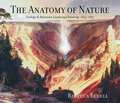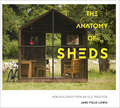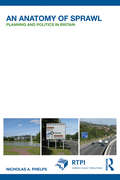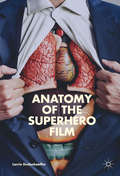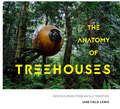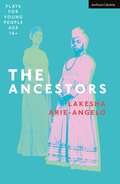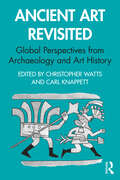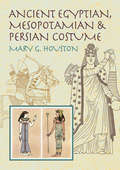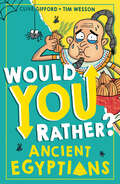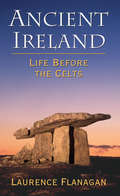- Table View
- List View
The Anatomy of Nature: Geology and American Landscape Painting, 1825-1875
by Rebecca BedellAn illuminating account of the interplay between science, religion, and nature in nineteenth-century landscape paintingGeology was in vogue in nineteenth-century America. People crowded lecture halls to hear geologists speak, and parlor mineral cabinets signaled social respectability and intellectual engagement. This was also the heyday of the Hudson River School, and many prominent landscape painters avidly studied geology. Thomas Cole, Asher Durand, Frederic Church, John F. Kensett, William Stanley Haseltine, Thomas Moran, and other artists read scientific texts, participated in geological surveys, and carried rock hammers into the field to collect fossils and mineral specimens. As they crafted their paintings, these artists drew on their geological knowledge to shape new vocabularies of landscape elements resonant with moral, spiritual, and intellectual ideas.Rebecca Bedell contributes to current debates about the relationship among art, science, and religion by exploring this phenomenon. She shows that at a time when many geologists sought to disentangle their science from religion, American artists generally sidestepped the era's more materialist science, particularly Darwinism. They favored a conservative, Christianized geology that promoted scientific study as a way to understand God. Their art was both shaped by and sought to preserve this threatened version of the science. And, through their art, they advanced consequential social developments, including westward expansion, scenic tourism, the emergence of a therapeutic culture, and the creation of a coherent and cohesive national identity.This major study of the Hudson River School offers an unprecedented account of the role of geology in nineteenth-century landscape painting. It yields fresh insights into some of the most influential works of American art and enriches our understanding of the relationship between art and nature, and between science and religion, in the nineteenth century. It will draw a broad audience of art historians, Americanists, historians of science, and readers interested in the American natural landscape.
The Anatomy of Nature: Geology and American Landscape Painting, 1825-1875
by Rebecca BedellAn illuminating account of the interplay between science, religion, and nature in nineteenth-century landscape paintingGeology was in vogue in nineteenth-century America. People crowded lecture halls to hear geologists speak, and parlor mineral cabinets signaled social respectability and intellectual engagement. This was also the heyday of the Hudson River School, and many prominent landscape painters avidly studied geology. Thomas Cole, Asher Durand, Frederic Church, John F. Kensett, William Stanley Haseltine, Thomas Moran, and other artists read scientific texts, participated in geological surveys, and carried rock hammers into the field to collect fossils and mineral specimens. As they crafted their paintings, these artists drew on their geological knowledge to shape new vocabularies of landscape elements resonant with moral, spiritual, and intellectual ideas.Rebecca Bedell contributes to current debates about the relationship among art, science, and religion by exploring this phenomenon. She shows that at a time when many geologists sought to disentangle their science from religion, American artists generally sidestepped the era's more materialist science, particularly Darwinism. They favored a conservative, Christianized geology that promoted scientific study as a way to understand God. Their art was both shaped by and sought to preserve this threatened version of the science. And, through their art, they advanced consequential social developments, including westward expansion, scenic tourism, the emergence of a therapeutic culture, and the creation of a coherent and cohesive national identity.This major study of the Hudson River School offers an unprecedented account of the role of geology in nineteenth-century landscape painting. It yields fresh insights into some of the most influential works of American art and enriches our understanding of the relationship between art and nature, and between science and religion, in the nineteenth century. It will draw a broad audience of art historians, Americanists, historians of science, and readers interested in the American natural landscape.
Anatomy of Performance Training
by John MatthewsWe train because we are human and we become human because we train. This is the surprising and original conclusion of Anatomy of Performance Training, in which John Matthews shows how training is a very human response to the problems of having a body and living in the world. Using illustrative case-studies of professional practice, each chapter addresses a specific body part, offering a self-contained discussion of its symbolic and practical significance in the artistic, and commercial, activities of training. These anatomical case-studies are cross-referenced with other disciplines (such as sport, high diving, deep diving and artisan craft) to further expand our understanding of performance. Stand-alone chapters, ideal for reference, build towards an overall conclusion that the uniquely human practice of training is emerging as a new and pervasive ideology globally.Ideal for readers seeking to understand the relationship the body has with the theatre and training, or for teachers looking for a new, innovative approach to performance, Anatomy of Performance Training is an accessible, original contribution to the philosophy of training for performance.
Anatomy of Performance Training: Embodiment Philosophy And Practice
by John MatthewsWe train because we are human and we become human because we train. This is the surprising and original conclusion of Anatomy of Performance Training, in which John Matthews shows how training is a very human response to the problems of having a body and living in the world. Using illustrative case-studies of professional practice, each chapter addresses a specific body part, offering a self-contained discussion of its symbolic and practical significance in the artistic, and commercial, activities of training. These anatomical case-studies are cross-referenced with other disciplines (such as sport, high diving, deep diving and artisan craft) to further expand our understanding of performance. Stand-alone chapters, ideal for reference, build towards an overall conclusion that the uniquely human practice of training is emerging as a new and pervasive ideology globally.Ideal for readers seeking to understand the relationship the body has with the theatre and training, or for teachers looking for a new, innovative approach to performance, Anatomy of Performance Training is an accessible, original contribution to the philosophy of training for performance.
The Anatomy of Sheds
by Jane Field-LewisSheds are no longer neglected buildings at the end of the garden. As shown in this book, they have become an area of our home to be discovered by creative designers who see the garden as an extendable space of the home, whether in the heart of the city or in a larger rural setting. Today’s sheds are stylish, innovative and elegant and can be used for a multitude of purposes. They can be artists’ studios, writers’ retreats, children’s playgrounds or teenage dens, entertaining spaces, log cabins or garden rooms, or even just a traditional humble shed used for storage and plants but revamped with more stylish and decorated overtones. Using over 50 real examples from around the world, some simple and modest and some really extravagant, this book helps inspire and instruct the reader on how to create your own special space. The owners themselves describe how they have created their own private hideaways and Jane Field-Lewis provides insightful style notes and comments based on her conversations with the owners, architects and designers. She tells you how to create your shed depending on how you want to use it, and then how to make it stylish as well as useful. An intrinsic part of their charm is that normal decorating rules don’t apply and this gives the owners the freedom to express themselves in a different way without necessarily following any fashion or trends. Recycled, vintage and precious items are mixed with new, functional and practical ones. Jane Field-Lewis covers all these aspects in a warm-hearted way. The stunning photographs are accompanied by informative captions to help the reader design and decorate their shed on a more practical level. This is the book to help you create an inspiring space. Word Count: 40,000
An Anatomy of Sprawl: Planning and Politics in Britain (RTPI Library Series)
by Nicholas A. PhelpsDespite the combined efforts of British planners, politicians, the public and interest groups, the ‘Solent City’ stands as one of a number of instances of a peculiar instance of urban sprawl – muted, and slow to emerge – yet produced paradoxically by very strong interests in promoting conservation and restraint. This unique and valuable case study, while focusing on the planning and development of South Hampshire in particular, enables an in-depth study of the issues surrounding planning strategies with regards to growing populations.
An Anatomy of Sprawl: Planning and Politics in Britain (RTPI Library Series)
by Nicholas A. PhelpsDespite the combined efforts of British planners, politicians, the public and interest groups, the ‘Solent City’ stands as one of a number of instances of a peculiar instance of urban sprawl – muted, and slow to emerge – yet produced paradoxically by very strong interests in promoting conservation and restraint. This unique and valuable case study, while focusing on the planning and development of South Hampshire in particular, enables an in-depth study of the issues surrounding planning strategies with regards to growing populations.
The Anatomy Of Style: Figure Drawing Techniques
by Patrick J. Jones Pat WilshireStructure + Gesture = Style! This simple formula is the idea behind the art of multi-award-winning figurative artist and teacher Patrick J. Jones. In this in-depth, step-by-step life drawing masterclass, Patrick expands on this formula and explores and explains the foundational techniques for drawing anatomically accurate figures with style, confidence and grace. Using his own beautifully realized artworks as examples – including his legendary annotated “Masterclass Study Sheets”, until now only seen by his students – Patrick shares his creative process, and offers invaluable tips and advice on everything from choosing the best drawing tools to identifying the key “landmarks” of the body. Patrick J. Jones is the author of the award- winning #1 bestseller Sci-Fi & Fantasy Oil Painting Techniques.
Anatomy of the Superhero Film
by Larrie DudenhoefferThis book addresses what a superhero body can do by developing several “x-rays” of the superbody’s sensoria, anatomic structures, internal systems, cellular organizations, and orthotic, chemical, or technological enhancements. In short, these x-rays offer what we might describe as a metamorpho-physiological approach to the superheroes in feature films, theatrical cartoon shorts, and Netflix television series. This approach examines the ways in which the “substance” of superheroes, which includes their masks, costumes, chevrons, weapons, and auras, extends into the diegetic environment of the film, transgressing it, transforming it, and corporealizing it, making it emblematic of the shape, dimensions, contours, and organismic workings of one or more of our major organs, members, orifices, fluids, or cell clusters. Thus the superhero film, as this study claims, works to make us more aware of the mutability, adaptability, modifiability, and virtual capabilities of our own flesh.
Anatomy of the Superhero Film
by Larrie DudenhoefferThis book addresses what a superhero body can do by developing several “x-rays” of the superbody’s sensoria, anatomic structures, internal systems, cellular organizations, and orthotic, chemical, or technological enhancements. In short, these x-rays offer what we might describe as a metamorpho-physiological approach to the superheroes in feature films, theatrical cartoon shorts, and Netflix television series. This approach examines the ways in which the “substance” of superheroes, which includes their masks, costumes, chevrons, weapons, and auras, extends into the diegetic environment of the film, transgressing it, transforming it, and corporealizing it, making it emblematic of the shape, dimensions, contours, and organismic workings of one or more of our major organs, members, orifices, fluids, or cell clusters. Thus the superhero film, as this study claims, works to make us more aware of the mutability, adaptability, modifiability, and virtual capabilities of our own flesh.
The Anatomy of Treehouses: New Buildings From An Old Tradition
by Jane Field-LewisThe treehouse in its most simple and fundamental form enables us to escape from the everyday pressures of modern life and feel closer to nature.
The Ancestors (Plays for Young People)
by Lakesha Arie-AngeloA clique of Caribbean maroon warrior women, a general of Haiti and his right-hand man, an ex-enslaved couple reclaiming their land, a group of Black French Caribbean soldiers held captive in Portchester and their wives travelling across the Atlantic to be reunited with them. These are The Ancestors: manifesting in our world, in the hopes we can stop history repeating itself. But do we really hold the key? What dark forces are still currently at play?In October 1796 a fleet of ships from the Caribbean carrying over 2,500 prisoners-of-war, who were mostly Black or mixed-race, began to arrive in Portsmouth Harbour. By the end of that month, almost all of them were held at Portchester Castle, accompanied by their families. About 100 women and children were sent to live nearby.The Ancestors is a site-specific play by Lakesha Arie-Angelo that explores the grounds of Portchester Castle and the voices of Black revolutionaries imprisoned therein that history forgot. It was commissioned by the National Youth Theatre as part of Freedom and Revolution, a collaboration with English Heritage's Shout Out Loud Programme and University of Warwick aimed at shining a new light on the lives of these prisoners with the participation of local young people.The Ancestors is published in Methuen Drama's Plays For Young People Age series which offers suitable plays for young performers at schools, youth groups and youth theatres that have each had premiere productions by young performers in the UK.
The Ancestors (Plays for Young People)
by Lakesha Arie-AngeloA clique of Caribbean maroon warrior women, a general of Haiti and his right-hand man, an ex-enslaved couple reclaiming their land, a group of Black French Caribbean soldiers held captive in Portchester and their wives travelling across the Atlantic to be reunited with them. These are The Ancestors: manifesting in our world, in the hopes we can stop history repeating itself. But do we really hold the key? What dark forces are still currently at play?In October 1796 a fleet of ships from the Caribbean carrying over 2,500 prisoners-of-war, who were mostly Black or mixed-race, began to arrive in Portsmouth Harbour. By the end of that month, almost all of them were held at Portchester Castle, accompanied by their families. About 100 women and children were sent to live nearby.The Ancestors is a site-specific play by Lakesha Arie-Angelo that explores the grounds of Portchester Castle and the voices of Black revolutionaries imprisoned therein that history forgot. It was commissioned by the National Youth Theatre as part of Freedom and Revolution, a collaboration with English Heritage's Shout Out Loud Programme and University of Warwick aimed at shining a new light on the lives of these prisoners with the participation of local young people.The Ancestors is published in Methuen Drama's Plays For Young People Age series which offers suitable plays for young performers at schools, youth groups and youth theatres that have each had premiere productions by young performers in the UK.
Ancient Art Revisited: Global Perspectives from Archaeology and Art History
by Christopher Watts Carl KnappettAncient Art Revisited develops new perspectives on ancient art by weaving together diverse strands within archaeology and art history, exploring it through recent developments in archaeological theory. In order to foster dialogue among various subfields, contributors are drawn from a wide range of domains. Classical archaeology, Aegean prehistory, Near Eastern archaeology, Egyptology, Pre-Columbian South America, and North America are brought together to explore ancient art from multiscalar perspectives and through the lenses of entanglement theory, network thinking, assemblage theory, and other recent theoretical developments. Representing a new wave in research on ancient art, considering both the proximal and distributed operations of artworks, Ancient Art Revisited provides broad and inclusive coverage of ancient art and offers a cohesive approach to a fragmented area of study. This book will be suitable for archaeologists, anthropologists, and art historians wishing to understand the latest thinking on ancient art.
Ancient Art Revisited: Global Perspectives from Archaeology and Art History
by Christopher Watts Carl KnappettAncient Art Revisited develops new perspectives on ancient art by weaving together diverse strands within archaeology and art history, exploring it through recent developments in archaeological theory. In order to foster dialogue among various subfields, contributors are drawn from a wide range of domains. Classical archaeology, Aegean prehistory, Near Eastern archaeology, Egyptology, Pre-Columbian South America, and North America are brought together to explore ancient art from multiscalar perspectives and through the lenses of entanglement theory, network thinking, assemblage theory, and other recent theoretical developments. Representing a new wave in research on ancient art, considering both the proximal and distributed operations of artworks, Ancient Art Revisited provides broad and inclusive coverage of ancient art and offers a cohesive approach to a fragmented area of study. This book will be suitable for archaeologists, anthropologists, and art historians wishing to understand the latest thinking on ancient art.
Ancient Carpenters' Tools: Illustrated and Explained, Together with the Implements of the Lumberman, Joiner and Cabinet-Maker i
by Henry C. MercerClassic reference describes in detail hundreds of implements in use in the American colonies in the 18th century. Over 250 illustrations depict tools identical in construction to ancient devices once used by the Greeks, Egyptians, and Chinese, among them axes, saws, clamps, chisels, mallets, and much more. An invaluable sourcebook.
Ancient Egyptian Art and Architecture (Very Short Introductions Ser.)
by Christina RiggsFrom Berlin to Boston, and St Petersburg to Sydney, ancient Egyptian art fills the galleries of some of the world's greatest museums, while the architecture of Egyptian temples and pyramids has attracted tourists to Egypt for centuries. But what did Egyptian art and architecture mean to the people who first made and used it - and why has it had such an enduring appeal? In this Very Short Introduction, Christina Riggs explores the visual arts produced in Egypt over a span of some 4,000 years. The stories behind these objects and buildings have much to tell us about how people in ancient Egypt lived their lives in relation to each other, the natural environment, and the world of the gods. Demonstrating how ancient Egypt has fascinated Western audiences over the centuries with its impressive pyramids, eerie mummies, and distinctive visual style, Riggs considers the relationship between ancient Egypt and the modern world. ABOUT THE SERIES: The Very Short Introductions series from Oxford University Press contains hundreds of titles in almost every subject area. These pocket-sized books are the perfect way to get ahead in a new subject quickly. Our expert authors combine facts, analysis, perspective, new ideas, and enthusiasm to make interesting and challenging topics highly readable.
Ancient Egyptian Art and Architecture: A Very Short Introduction (Very Short Introductions)
by Christina RiggsFrom Berlin to Boston, and St Petersburg to Sydney, ancient Egyptian art fills the galleries of some of the world's greatest museums, while the architecture of Egyptian temples and pyramids has attracted tourists to Egypt for centuries. But what did Egyptian art and architecture mean to the people who first made and used it - and why has it had such an enduring appeal? In this Very Short Introduction, Christina Riggs explores the visual arts produced in Egypt over a span of some 4,000 years. The stories behind these objects and buildings have much to tell us about how people in ancient Egypt lived their lives in relation to each other, the natural environment, and the world of the gods. Demonstrating how ancient Egypt has fascinated Western audiences over the centuries with its impressive pyramids, eerie mummies, and distinctive visual style, Riggs considers the relationship between ancient Egypt and the modern world. ABOUT THE SERIES: The Very Short Introductions series from Oxford University Press contains hundreds of titles in almost every subject area. These pocket-sized books are the perfect way to get ahead in a new subject quickly. Our expert authors combine facts, analysis, perspective, new ideas, and enthusiasm to make interesting and challenging topics highly readable.
Ancient Egyptian, Mesopotamian & Persian Costume
by Mary G. HoustonClothing was hardly a practical necessity in North Africa and what is today the Middle East. Often a luxury item in these warm, humid climates, it became more essential as people's lives improved socially and economically. But even then, the drapery was light and tended to accent the body's shape rather than conceal it. The first part of this profusely illustrated and scrupulously researched text examines the evolution in apparel worn by Egyptian royalty, priests, musicians, manual workers, the military, and foreigners (as depicted by Egyptian artists). Two additional sections consider clothing worn in ancient Mesopotamia and Persia, focusing largely on Sumerian, Babylonian, and Assyrian styles. Over 250 illustrations, drawn in the artistic style of the period, are accompanied by flat patterns showing the cut of the garment, thus enabling today's costumers to accurately reconstruct this apparel. A comprehensive archive that will not only be of immense value to fashion historians and students of costume design, this volume will also fascinate anyone interested in the development of artistic representation.
Ancient Egyptians (Would You Rather?)
by Clive GiffordWould you rather be a pharaoh or a pharaoh’s servant? Cleopatra or Queen Hatshepsut? Only you can decide!
Ancient Greece and Rome in Modern Science Fiction: Amazing Antiquity (Greece and Rome Live)
by Ross ClareAncient Greece and Rome in Modern Science Fiction introduces and analyses the reception of classical antiquity in contemporary science fiction. By using up-to-date methods from classical reception theory, science-fiction analysis and fictional-world studies, the book will help furnish the reader’s understanding of the ways in which the literature, culture, history and mythology of ancient Greece and Rome are appropriated and represented across multiple media platforms in the science-fiction genre today. The book will therefore serve as an entry point into several areas of study: the reception of classics in popular culture, antiquity in modern media, the uses of the ancient world in science-fiction, and broader science-fiction criticism. The chapters – structured by medium – principally offer a roughly chronological overview of that medium and its treatment of ancient history, mythology, literature and culture. An abundance of case studies from literature, film and television and videogames including Star Trek, Battlestar Galactica, Fallout: New Vegas, the Mass Effect franchise and Assassin’s Creed show how classical antiquity is reused, encountered, re-encountered by creators and consumers of the present – how we bounce off it, and it bounces off us, and how this reciprocation creates new visions of Greece and of Rome.
Ancient Greek History and Contemporary Social Science
by Mirko Canevaro Andrew ErskineA wide-ranging study of shifting temporalities and their literary consequences in twentieth-century fiction
Ancient Greek History and Contemporary Social Science
by Mirko Canevaro Andrew ErskineThe first full-length academic study to deal exclusively with female stardom in British cinema
Ancient Greek, Roman & Byzantine Costume
by Mary G. HoustonThis scrupulously researched and abundantly illustrated book includes 315 drawings based on renderings by artists of the period to achieve utmost accuracy and authenticity.Included are elaborate examples of Aegean costume, Doric and Ionic styles of dress for women, Greek and Roman armor, graceful and intricately arranged Roman togas, the tunica — roomy, wide-sleeved apparel; and the pallium, a cloak-like garment. Ornate vestments of the Eastern Orthodox Church and Byzantine costumes are carefully described and portrayed, as are styles of hairdressing, jewelry, and other decorative elements.An excellent reference for the history classroom, the volume also includes instructions and flat patterns showing the cut of sample garments, making it easy for costume designers to reproduce period apparel. This book will be valuable as well to costume historians and art students interested in the development of representative art.
Ancient Ireland: Life Before the Celts
by Laurence FlanaganWhen the Celts first arrived in Ireland around 200 B.C., the island had already been inhabited for over 7000 years. Drawing on a wealth of archaeological evidence and the author's own mastery of the subject, Ancient Ireland returns to those pre-Celtic roots in a bid to discover the secrets of the island's first inhabitants: Who were they? And how did they live? Few accounts of the period are as exhaustively researched; fewer still are as alive with historical insight and compelling detail. At once accessible and comprehensive, Ancient Ireland is an indispensable guide to early Irish civilisation, its culture and mythology.
